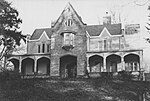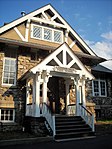Mandeville House

The Mandeville House is located on Lower Station Road (Putnam County Route 12) in Garrison, New York, United States, just west of its intersection with NY 9D and 403. It is the oldest extant house in that community, dating to 1735.During the Revolutionary War, General Israel Putnam, after whom the county is named, was headquartered there for a while. A later occupant, architect Richard Upjohn, lived there for the last 25 years of his life. He expanded the house and redid its exterior in the Gothic Revival style that characterized much of his own work; most of these were removed in the 1920s by a later owner in order to restore the house to something close to its original appearance. In 1982 it was listed on the National Register of Historic Places. In the early 2000s it has been the subject of a dispute between the foundation which owns it and local history enthusiasts. The latter claim the head of the foundation is improperly using it as a residence and has not fully complied with Internal Revenue Service requirements that the house be open to the public as a museum. The head of the foundation denies any impropriety.
Excerpt from the Wikipedia article Mandeville House (License: CC BY-SA 3.0, Authors, Images).Mandeville House
Lower Station Road,
Geographical coordinates (GPS) Address Nearby Places Show on map
Geographical coordinates (GPS)
| Latitude | Longitude |
|---|---|
| N 41.376666666667 ° | E -73.945 ° |
Address
Lower Station Road 122
10524
New York, United States
Open on Google Maps








